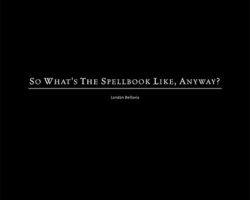So What’s The Spellbook Like, Anyway? by Landon Bellavia is a role playing game supplement published by Raging Swan Press for use with the Pathfinder Roleplaying Game. As such, it is covered by the Open Game License and some parts are considered to be Open Game Content as a result.
 The supplement is available as a 25-page PDF from DriveThruRPG for $3.99 but was obtained at a reduced price as part of a special bundle. Two pages are the front and rear covers, three the front matter, Contents and Foreword, one page is an ad and one is the Open Game License. The PDF comes in two versions, one designed for print and high-end devices, the other for mobile and low-end devices.
The supplement is available as a 25-page PDF from DriveThruRPG for $3.99 but was obtained at a reduced price as part of a special bundle. Two pages are the front and rear covers, three the front matter, Contents and Foreword, one page is an ad and one is the Open Game License. The PDF comes in two versions, one designed for print and high-end devices, the other for mobile and low-end devices.
Using the Tables explains that the supplement is intended to make a wizard’s spellbook interesting, and that there are cases when knowing more about a spellbook than just what spells it contains can be important. The section then goes into details as to how to use each table, or group of tables, with examples in some cases.
Table A: Spellbook Titles is comprised of a d100 list of descriptors, a d20 list of title subjects and a d12 list of sample books.
Table B: Wizards Name and Epithet has two d100 tables, each with 50 results, of names and epithets, and a d20 table of sample wizards.
Table C: Distinguishing Features is a d100 list with 50 results of unusual features for the book.
Table E: Spellbook Cover Material has a d100 list of cover materials, with notes covered later, and a d20 table of cover condition.
Table E: Cover is divided into six groups of six results. The groups all reference the cover material from Table D.
Table F: Paper has a d100 list with 50 results for paper and a d20 list for paper condition.
Table G: Ink had a d100 list with 50 results for ink used.
Table H: Preparation Rituals references the rituals introduced in Ultimate Magic and are used to add a slight boon to books. This is a d10 list.
Table I: Contents Other Than Spells is a d100 list with 50 results as to what else might be found in the spellbook.
Table J: History of the Spellbook and its Author has a d20 list of basic knowledge and a d20 list of tough knowledge.
Table K: Protection on the Spellbook is a list of different protections that could be found. D100 is rolled, with higher level spellbooks having more options and likely having more dangerous protections.
Table L: Random Spellbook Cost and Contents is a d100 table for randomly determining the value, level and spell levels in a spellbook.
Table M: Pre-Generated Spellbooks has 13 sample spellbooks, which can then be modified using the previous tables.
So What’s The Spellbook Like, Anyway? in Review
The PDF is bookmarked with major and minor sections linked. The Contents isn’t as thorough, but is hyperlinked. Navigation is good. The text maintains a two-column format and appeared to be free of errors. There are a number of appropriate black and white illustrations. Presentation is decent.
This supplement isn’t really suitable for using on the fly, as there are a lot of options which will make it a bit time consuming. However, it does provide a lot of ways for making a discovered spellbook far more interesting ahead of time, making them unique items rather than just a spellbook with a bunch of spells in it. Much of it is also suitable for use with other systems, too. So What’s The Spellbook Like, Anyway? is a nice little supplement and it can be found by clicking here.

Leave a Reply